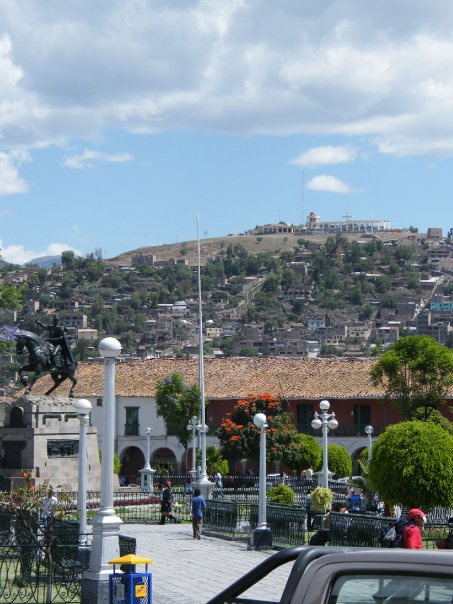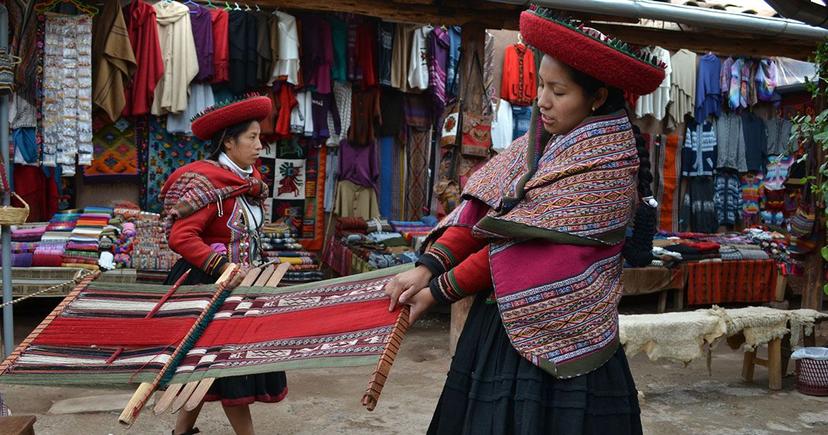
Situated off the beaten tourist track, Ayacucho lies nestled in the Andes Mountains, ready and waiting to be discovered as the latest little-known Peru travel destination. Despite its rocky history, Ayacucho is safe and welcoming to foreigners, offering a slice of genuinely authentic Andean culture.

Ayachucho Cathedral at night
The Plaza de Armas of Ayacucho is beautifully developed, with a stunning cathedral on the east side and lush green grasses surrounding a central fountain. Take a visit to the central market and you’ll find you’re probably the only person in there that doesn’t speak Quechua. Rows of Señora’s stand in front of huge sacks of ‘wawa’, fresh-baked sweet bread, in the shape of a baby after its Quechua name.
When your face appears at the juice bars, the women lean over their counters smiling and waving you over, competing for your business. Walking down the aisle of smelly cheeses, you’ll pop out onto the back street where against the wall, you’ll find huge sacks of coca leaves, and men and women, young and old coming to buy coca.
Sadly, in the 1980s, the city and region of Ayacucho were affected by unrest caused by the Maoist guerrilla band, known as the Shining Path. Combined with the Peruvian military’s often harsh reaction, the unrest caused Ayacucho to become one of the poorest regions of Peru. Fortunately the strife ended with the arrest of the Shining Path’s leader in 1992 and Ayacucho has been a peaceful place for more than 15 years.
Peru Tours:
This difficult history has left Ayacucho struggling to develop as a tourist destination despite its stunning location and friendly inhabitants. The city offers visitors a balance between modern comforts and traditional culture. In the center you’ll find quality hotels with hot water, restaurants with English menus serving a wide variety of dishes beyond the locally popular pollo a la brasa and puca picante. There’s an artisan market that makes souvenir buying easy and offers among the cheapest prices on Peruvian handicrafts you’ll find anywhere in the country.
I was in Ayacucho long enough to become a regular at the juice counter, trying to spread my custom around though it’s difficult when these sweet ladies smile in recognition of my face and call up my usual without a moment’s thought, ‘platano con leche.’ They always had plenty of customers anyway, no matter when I showed up.
The downtown is a far cry from what you’ll find in the outer districts of the city, where people live very simply without many of the comforts of modern life. Taking the bus up the hill to the orphanage where I was a volunteer , I’d sit next to a tired old woman, with a sun-dried face under a brown, flat-brimmed hat, huge bundles of vegetables filled a rice-sack at her feet and a young baby wrapped around her back in a brightly colored wool shawl. Soon, I’d stand up to give up my seat to another woman, looking the same.

Central Ayacucho
Climbing down from the bus to the dusty, rubble streets of Carmen Alto, children are playing soccer in sandals made of tire, and an old toothless man is standing on the corner selling cheese. Listening to the playful banter of the children however, you wouldn’t know they had a problem in the world.
Looking across the city tucked down in the valley to the 10,000 ft mountains on the other side, you can see the large white obelisk at Quinua. Just an hour away, this is the site of the Battle of Ayacucho, winning Peru the War of Independence in 1824. Nowadays, you can explore the quaint little town, famous for beautiful handcrafted pottery, horseback riding and its short hike to a beautiful waterfall.
The well-preserved Wari ruins are located just below Quinua on your way back to Ayacucho. The hiking is beautiful, and the rich history of the ancient Wari culture is evident in administrative and ceremonial sites. Exploring off the path a little bit and you’ll find broken shards of pottery and arrowheads scattered on the ground. Quinua and Wari are just two of the easy excursions from Ayacucho. Another popular day trip is the beautiful natural turquoise pools of Millpu in Ayacucho’s countryside.
Ayacucho can be reached daily from Lima in just over an hour flight with LC Busre or Star Peru. In fact, there are rumors of a regular Ayacucho – Cusco flight being added to the agenda in the next couple years, which will quickly boost the tourism industry in Ayacucho, linking it as an easy stop-over on a Machu Picchu tour . The city is certainly ready for it.
So, check your Peru itineraries, because maybe now is the best time to go before the city loses some of that undiscovered quality.
Emily was a volunteer for the Casa Hogar Los Gorriones in Ayacucho, Peru. If you would like to learn more about volunteering at Los Gorriones or how you can help, please visit their website.
Experience a tour of Peru. Call and talk with an expert travel advisor !



Email: [email protected]
Sign up to receive our newsletter for great articles, stunning photos, and special deals.